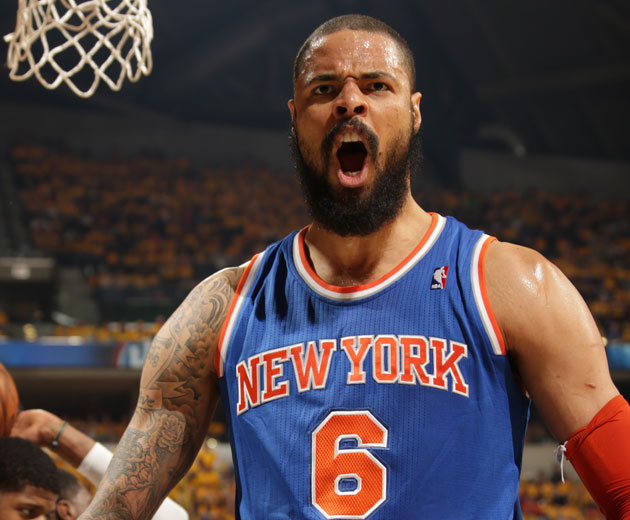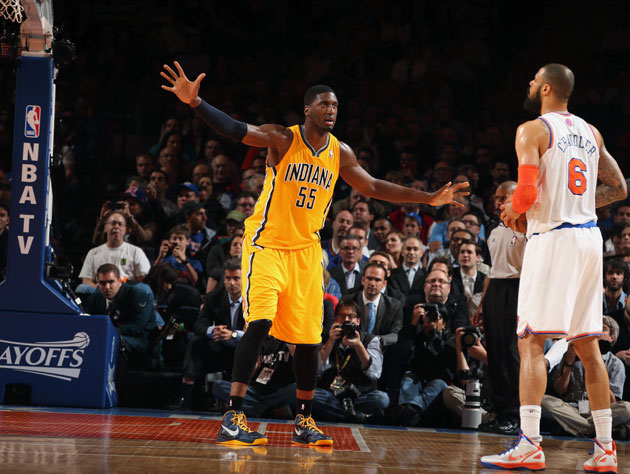
After months of looking like the Eastern Conference’s bona-fide Numbah Two behind the Miami Heat, and anticipating a coronated showdown with a Heat team they have blown out twice in the regular season, the New York Knicks are in danger of not even making it out of the second round. The Indiana Pacers have earned a 2-1 series lead over New York, though in typical NBA fashion the Knicks won’t admit to any problems outside of their own particular house.
Tyson Chandler took the lead between Games 3 and 4, talking to the New York Daily News’ Frank Isola about a fractured offense that has looked both stagnant and timid at times, two words that certainly would not have been used to describe the Knicks at their offensive best during the early stages of the 2012-13 season. Chandler has struggled terribly in this series on both ends, as the possibly-injured center has been bested by Pacers big man Roy Hibbert throughout the back and forth, so he took great pains to not single any teammate out by name.
Still, the message is clear. The team has to find away to get back to its motion-influenced, highly effective Heat-thwarting offense. Even before the team takes on the Heat. From the Daily News:
“Honestly, we’re doing it to ourselves,” Chandler said on Sunday. “I watched the tape myself and there are open looks. We have to be willing passers. You have to sacrifice yourself sometimes for the betterment of the team and for the betterment of your teammates.
"So when you drive in the paint and you draw, you kick it. I think we need to do a better job of allowing the game to dictate who takes the shots and not the individuals.”
Chandler, a wise veteran, was careful not to single out any one player. He didn’t mention Raymond Felton, who went 1-for-8 in Game 2 with two assists and three turnovers. He never identified Smith, who is battling the flu and made just four of 12 shots in 25 minutes. And he certainly didn’t point a finger at Anthony, who was 6-for-16 in 37 minutes.
Of course, a case could be made that Anthony needs to shoot more. He attempted just three shots in the fourth quarter of Game 3 and missed all of them. Woodson also felt that three shots isn’t enough for his All-Star forward and now Woodson is considering putting the ball in Anthony’s hands to initiate the offense.
Isola went on to quote Chandler as pointing out that he wasn’t offering criticism to be “malicious,” which makes sense. Not because Tyson is struggling so much (though he is self-aware enough to stop before saying anything out of line) but because there is often a difference between an unwilling passer, and an uncomfortable passer.
Players like Carmelo Anthony are often looked at as selfish because they decline to LeBron-it up and toss the pill around all the live-long day. I don’t doubt for a second that Carmelo Anthony would love to take home a win while tossing up a James-styled 20-point, nine-rebound, 10-assist night. It’s just that Anthony doesn’t have much confidence in himself as a quick passer, and in the heat of the moment that tends to take over when you know you can free yourself for a good look.
That may come off as needlessly defensive in regards to a player that has many times submarined his team’s offensive attacks (in Denver and New York) with isolation plays. When faced with having to hit someone like Chandler near the hoop or a shooter at the elbow with a quick pass against Indiana’s league-leading defense, though, things tend to change.
The issue for New York is determining whether or not this sort of change can be overcome. The team no doubt had a tough time watching tape of Game 3 (resulting in a mini team trip to a local Hooters Restaurant – it is illegal to buy beer in Indiana on Sunday’s, and that’s not me making a smartass joke), and the team has seen the places where they could have made an extra pass or two to mitigate Indiana’s defensive know-how. Putting this into practice and grabbing Game 4 won’t be easy. Even with the Pacers’ own ongoing offensive issues.
One key will have to be the re-establishing of the team’s three-point shot, a tool that the Knicks only utilized 11 times in their Game 3 loss, making three along the way. You wouldn’t think a lack of three-point chucking would seem like a problem. To many fans the shot still holds the stigma of the low-percentage, swing-for-the-fences ethos of yesteryear. A desperate attempt that teams would seem to want you to try.
Not in 2013, though. Larry Bird’s career 37 percent mark, one that seemed the gold standard as he judiciously put teams away with a late-game dagger three in the final minutes of a contest, would rank as the league’s average today. The Knicks have more scorers than shooters on their squad, especially when Steve Novak plays just brief minutes, but in massive bulk amounts the Knicks can become dangerous when firing away. The team led the NBA in attempts and makes from long distance this year, and taking threes in giant quantities helps the team in ways that the typical box score doesn’t fully describe.
The Wall St. Journal’s Chris Herring talked up the team’s worries from 24-feet out, starting with a quote from Pacers coach Frank Vogel:
"Our guys usually do what we emphasize. And we knew if you took away the three-ball from [the Knicks], they would struggle to score," Indiana coach Frank Vogel said. "You don't want to do it at the expense of giving things up at the rim, but we were able to protect the paint…and the three-point line."
Numbers support Vogel's point. The Knicks—who took, made and scored a larger percentage of their points from three than any other team in NBA history—were a Jekyll-and-Hyde sort of team depending on how often they shot from deep. They went 18-3 in games where they tried 33 or more triples, but Saturday's loss dropped them to just 10-11 when they take 23 or fewer. (They were also slightly more efficient in rebounding their own misses when they took a higher number of three-point shots.)
While the Knicks appeared to pass up a couple of open looks from distance (guards Iman Shumpert and Jason Kidd, in particular), the Pacers essentially locked up the three-point line by doing something most teams can't: Defend scoring champ Carmelo Anthony without ever needing to double-team.
Keep in mind that Anthony is sometimes locked up by the lionhearted David West, and not just the speedy, all-world defender that is Paul George. Anthony has not been at his best in this series – he dominated the ball too much in Game 1 and is shooting 41 percent overall – but we also need to cut the man some slack considering the level of opponent he’s going up against. Knick fans that didn’t pay attention to the Pacers this season, or NBA fans that are just catching up with the league as it hits the postseason should understand that George and West have been doing this all year long. And with Hibbert’s help, it’s no surprise that things are going pear-shaped offensively for New York at the worst possible time.

The problem for New York is that there are no ramifications to Roy Hibbert’s help. Tyson Chandler has not been able to make the big man pay, because Hibbert has become so adept at shading towards a possible scorer, and getting back to either take Chandler’s offense away, or grab a defensive rebound. So adept that the Knicks aren’t even looking to Tyson as a possible lob-and-finish candidate when he peels away after setting a screen.
Perhaps that’s on Tyson. Perhaps that’s on the flashy dudes, players like Anthony or the struggling Raymond Felton, with the ball. Maybe it’s all on Hibbert. Maybe the Pacers are that good.
The Knicks, sick and injured, have another day to figure it out. Life won’t end if the team has to move back to New York with a 3-1 deficit in hand, but it’ll sure feel like the blue marble is spinning wildly out of control. To the back pages, at least.
No comments:
Post a Comment